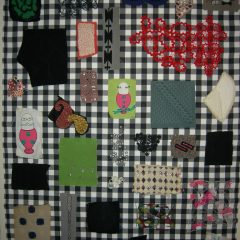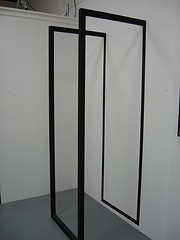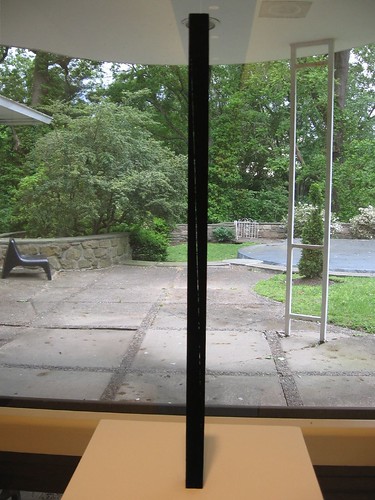
William Cromar, txx28, 1998, wood, casein and pigment, 26 x .75 x .75
Past Present: William Cromar Ten Years at the Design Center at Philadelphia University (up to July 11) has a pared down, almost Zen feel, each piece a kind of meditation on how we perceive, feel and occupy space.
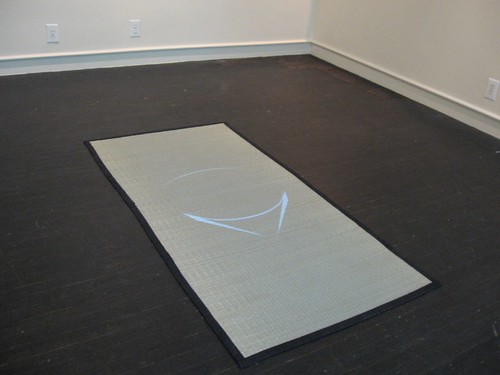
William Cromar, see d’, 2007-video installation, size varies with installation; the imagery moves to suggest shifting perspectives; the tatami mat screen emphasizes the Asian influence in Cromar’s work, much of which has the look of black lacquered wood.
Although Cromar is a professor in the school’s School of Architecture, this exhibit needs to be taken seriously as something more than an in-house vanity project by a school gallery.
The exhibit includes a video projection, a variety of vertical and horizontal sticks of smooth wood that look deceptively straight until contemplated, and other objects–most of them black. Several paper constructions and drawings are on similar themes–the four walls, the floor, right angles, and our relationship to them. The subject matter reflects Cromar’s background. The former architect, animator and musician was the co-recipient of a Silver Medal at the International Biennial of Architecture in Sofia, Bulgaria, for a film produced with an NEA grant. He had a Fleisher Challenge exhibit and currently has an installation, Gtmo, at Eastern State Penitentiary.
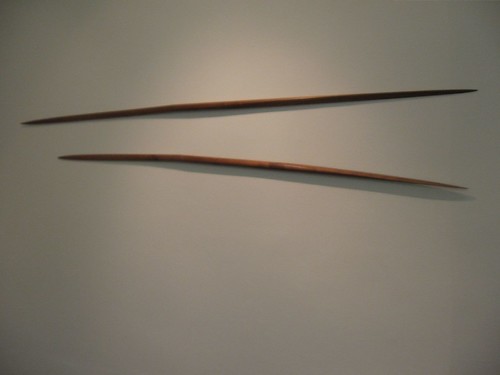
trp[041], 2004, wood, wax, 9x80x1; while this piece on the surface resembles work by Martin Puryear, it sticks close to its formalist concerns.
The work has a cool, cerebral quality. Pieces that look like they might be first cousins to Martin Puryear works are without the heat of shared remembrance and contested cultures. The titles add still another layer of cool–they seem like computer file names, or labels for lab cultures. txx28 for instance, bears no apparent relationship to the stick with a twist that presides over the entry hall (top image).
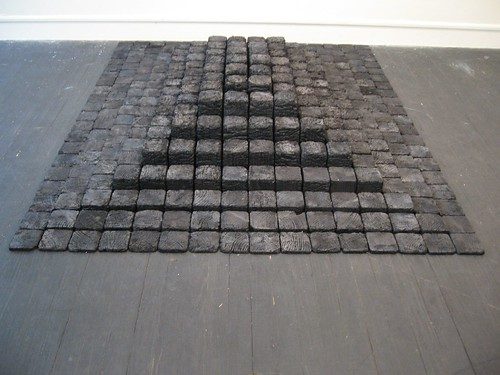
Only three of the 26 works in the show have decipherable titles. One, a pair of aymmetrical pyramids (and the only warm-colored piece in the show) is called progress (memorial for perpetual war). Another, also a kind of pyramid, this one of charred wooden blocks laid out on the floor, is called bed. They are the most overtly emotional pieces in the exhibit.

William Cromar, trp[04b], 2004, wood, ink, wax, 2 x 2 x 24
Cromar’s several vertical sticks become human stand-ins, rigid, lost in space, creating a fissure in the fabric of the daily world, not unlike Barnett Newman zips. The works play with expected, rectilinear space, talking to it without quite fitting in. The torques, tweaks and almost subliminal curves offer surprises, revealed by changes in perspective.
Pieces that appear to emerge from the wall or fireplace surfaces suggest a space beyond. Many of the pieces are caligraphic dashes and marks through space or on walls.
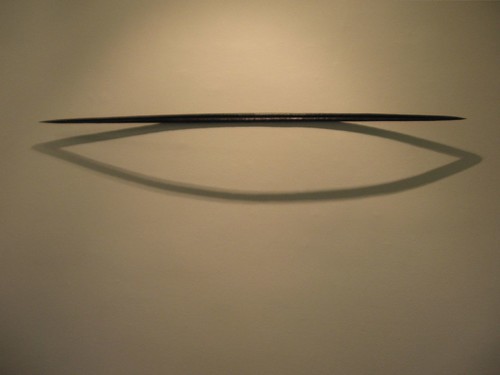
William Cromar, met[06a], wood, ink, wax, .75 x 72 x 12, 2000. The initial impression that the piece is a straight stick is undermined by the shadow.
With great economy of means and scale, Cromar slices though planes and then rests, leaving you, the viewer, to figure it all out. It’s the back and forth between the moving viewer and the static object that holds Cromar’s attention, and ours.
Part of what’s nice about this work is the way it fits in architectural spaces without giving up intellectual heft and aesthetic rigor. In other words, it would look great next to the sofa, but still have serious sculptural chops.
I am not generally someone who likes their work this minimal, but each time I see Cromar’s work, he somehow convinces me all over again.
Here are several older posts on Cromar:
William Cromar: Taking space
Newish galleries in town
Installation art on First Friday



